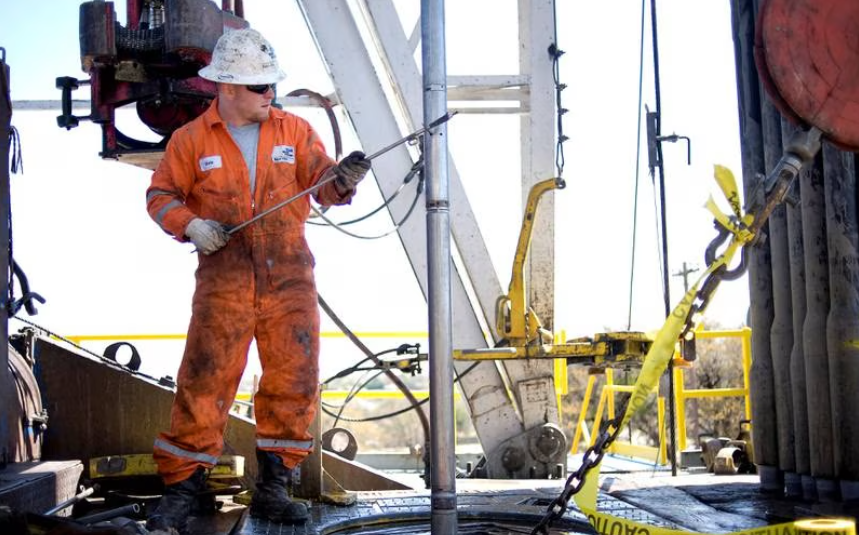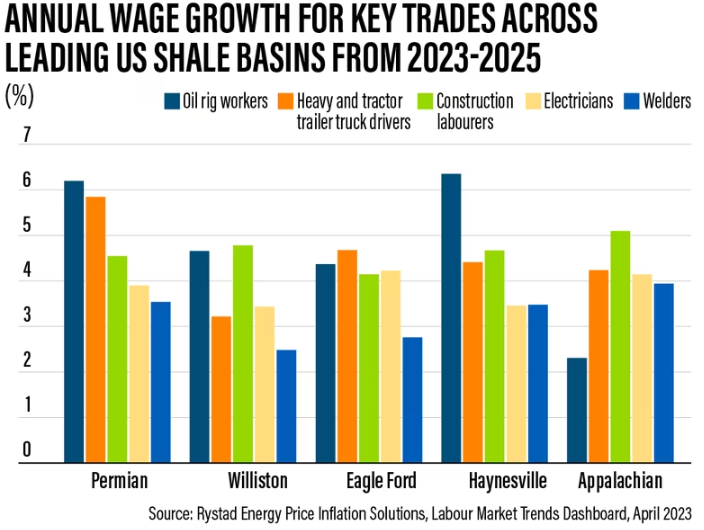Higher production in oil-rich Permian Basin is expected to add 7,000 jobs by the end of next year

Drilling for gas in Texas. Production in the Permian Basin, America's largest shale basin, is expected to rise by more than 10 per cent by the end of 2024.
Wages for workers in the US shale industry are forecast to remain “elevated” until 2024 as companies ramp up production in response to a surge in energy prices.
Average wage growth for key oil and gas roles is set to range between 2.5 per cent and 7.2 per cent this year and the next, Rystad Energy said.
The Norway-based consultancy said strong oil and gas production will spur labour growth in the industry, particularly in the oil-rich Permian Basin of Texas and New Mexico.
Production in the region is expected to rise by more than 10 per cent by the end of next year, creating 7,000 new jobs, Rystad said.
A US shale resurgence, centred around the Permian Basin, turned the country into the world’s largest crude producer in 2018.
The shale patch accounts for nearly 40 per cent of all oil production in America, and nearly 15 per cent of its natural gas production, according to the Federal Reserve Bank of Dallas.
The region is still seen as an attractive option for energy companies seeking a quick return on their investment.
“A combination of low labour force growth and unemployment levels, competition from the renewables sector and increased retirements should increase the bargaining power of job seekers in the shale patch,” Rystad said.
The US economy continued to churn out jobs at a brisk pace in March, government data showed earlier this month, in a sign of tightness in the labour market. Last month’s job growth of 236,000 was down from February’s gain of 326,000.
The unemployment rate fell to 3.5 per cent, not far above the 53-year low of 3.4 per cent set in January.
Labour market tightness has been more “pronounced” in the oil and gas sector, where unemployment stood at 3 per cent in February, Rystad said.
“The prevailing tightness in the US oil and gas labour market has thereby resulted in increased pain for industry players across leading shale basins as they have had to shell out a premium to attract and retain workers,” the consultancy said.
Wages in Midland County, in the core Permian Basin, surged nearly 14 per cent year-on-year by the third quarter of 2022, Rystad found.
This was higher than the average wage growth of 9 per cent in major oil producing counties across the country last year.

“After 2024, we expect operator spending levels to peak, production growth to slow down, and the impacts of the US Federal Reserve’s stringent monetary policies to become more evident,” Rystad said.
The Fed has raised interest rates nine times since March last year, from a near-zero rate to the current target range of 4.75 per cent to 5 per cent as it seeks to tame inflation.
The era of exponential growth in the US oil and gas sector “is over” as companies focus on boosting shareholder returns, Jeff Miller, chief executive of US oilfield services company Halliburton, said last year.
“We'll see growing investment, but quite frankly, nothing even close to what we saw from 2008 to 2014,” Mr Miller told a panel at the Abu Dhabi International Petroleum Exhibition and Conference in November.
The US Energy Information Administration, the statistical arm of the energy department, expects oil and gas production in the country to rise to 12.54 million barrels per day this year from 11.88 million bpd in 2022.
Output will rise to 12.75 million bpd in 2024, according to the EIA.
West Texas Intermediate, the gauge that tracks US crude, fell below $70 a barrel last month after the collapse of three major US banks rattled financial markets.
Oil prices have surged after Opec+ producers announced voluntary oil production cuts of 1.16 million bpd on April 2.
WTI is currently trading at about $77 a barrel.